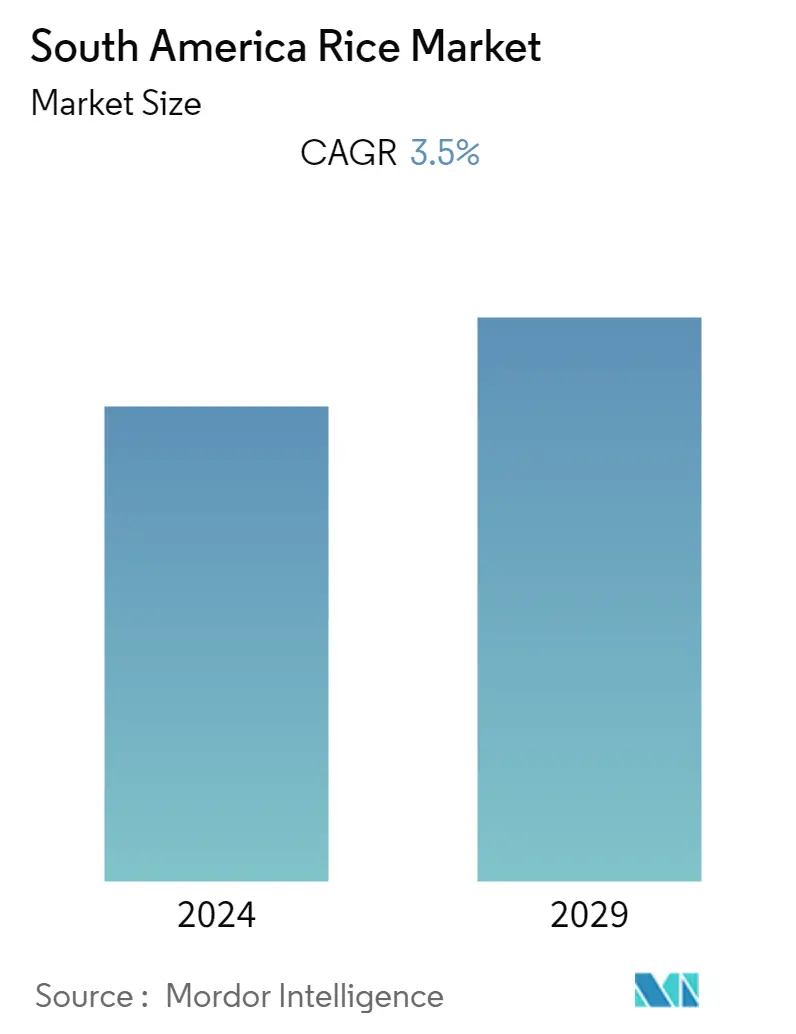Market Size of South America Rice Industry

| Study Period | 2019 - 2029 |
| Base Year For Estimation | 2023 |
| Forecast Data Period | 2024 - 2029 |
| Historical Data Period | 2019 - 2022 |
| CAGR | 3.50 % |
Major Players*Disclaimer: Major Players sorted in no particular order |
South America Rice Market Analysis
The South America rice market is estimated to record a CAGR of 3.5% during the forecast period.
- Rice is grown as a major staple crop in most countries of South America. The crop is cultivated in wet soils common in the lowlands of the region. The lowland rice expansion in the vast wetlands of Brazil (with a potential of 24 million hectares), the Andean countries (Bolivia, Ecuador, Peru, and Venezuela), and the River Plate Basin (Argentina, Paraguay, and Uruguay) would greatly influence the regional production of rice in the future. The tropical countries of the region account for the majority of demand.
- The Russia-Ukraine war had a negligible impact on the rice market because rice is not a staple in Russia and Ukraine. Therefore, there is no proportional price spike due to the invasion. However, the same is not the case for the price of other grains. The United Nations Food and Agriculture Organization's (UN-FAO) price index for cereal grains jumped 17.1% between February and March 2021, while the price index for rice remained stagnant, 10% lower than it was a year ago.
- Rice consumption is income elastic in the region, as consumers tend to increase consumption as their incomes rise. The yield in the region was 63,857 hg/ha in 2021, which increased compared to the previous year. Direct seeding and purchased inputs are used for cultivation across the region. Uruguay has gained the third-highest rice productivity in the world, with an average of 8 metric tons per hectare of dry paddy rice in the last 5 years. These factors are boosting the growth of the rice market in the region.
- Factors driving Brazil's transformation include agricultural research that has increased yields, expansion of the arable land base, significant investments in production technologies to develop crop and forage varieties, and increased global demand for food and animal feed, particularly over the last decade. These are anticipated to grow the market during the forecasting period.
South America Rice Industry Segmentation
Rice is the starchy seeds or grain of annual marsh grass, Oryza sativa, cultivated in warm climates and used for food. It is cultivated as the major staple crop and has economic importance in the region.
The South American rice market is segmented by geography into Brazil, Argentina, Uruguay, Chile, Peru, and the Rest of South America. The report includes production analysis (volume), consumption analysis (value and volume), export analysis (value and volume), import analysis (value and volume), and price trend analysis.
The report offers the market size and forecast in both value (USD million) and volume (metric ton).
| Geography (Production Analysis (Volume), Consumption Analysis (Value & Volume), Import Analysis (Value & Volume), Export Analysis (Value & Volume) and Price Trend Analysis) | |
| Brazil | |
| Argentina | |
| Chile | |
| Peru | |
| Rest of South America |
South America Rice Market Size Summary
The South American rice market is poised for steady growth, driven by the region's favorable climatic conditions and agricultural advancements. Rice serves as a crucial staple crop, particularly in tropical countries like Brazil, Peru, Colombia, and Ecuador. The expansion of lowland rice cultivation in Brazil and other regions, coupled with increased global demand for food and animal feed, is expected to bolster production. Brazil, as the largest producer and exporter, plays a pivotal role in the market, supported by significant investments in agricultural research and technology. The country's strategic partnerships, such as with Mercosur, aim to enhance its position as a global rice exporting hub, further driving market growth.
Despite being a net importer, South America's rice consumption has surged, making it the fastest-growing staple food in the region. The adoption of modern, climate-resilient rice varieties has improved production efficiency, catering to the rising demand. Rice is a vital protein source for the region's poorest populations, accounting for a significant portion of their diet. The market's expansion is also supported by Brazil's ability to increase agricultural productivity and its role as a major supplier to international markets. As the region continues to leverage its agricultural potential, the rice market is expected to experience sustained growth over the forecast period.
South America Rice Market Size - Table of Contents
-
1. MARKET DYNAMICS
-
1.1 Market Overview
-
1.2 Market Drivers
-
1.3 Market Restraints
-
1.4 Value Chain Analysis
-
-
2. MARKET SEGMENTATION
-
2.1 Geography (Production Analysis (Volume), Consumption Analysis (Value & Volume), Import Analysis (Value & Volume), Export Analysis (Value & Volume) and Price Trend Analysis)
-
2.1.1 Brazil
-
2.1.2 Argentina
-
2.1.3 Chile
-
2.1.4 Peru
-
2.1.5 Rest of South America
-
-
South America Rice Market Size FAQs
What is the current South America Rice Market size?
The South America Rice Market is projected to register a CAGR of 3.5% during the forecast period (2024-2029)
What years does this South America Rice Market cover?
The report covers the South America Rice Market historical market size for years: 2019, 2020, 2021, 2022 and 2023. The report also forecasts the South America Rice Market size for years: 2024, 2025, 2026, 2027, 2028 and 2029.

